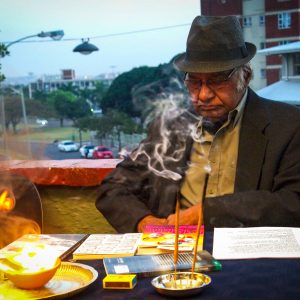Fred Khumalo’s coat of many colours
This latest offering of short stories, while mostly light hearted and irreverent, still succeeds in tackling important issues such as feminism, notions of harmful masculinity and more. It is Khumal…
Author:
31 May 2021

By the time the provocatively titled Bitches’ Brew garnered him international attention in 2006, Fred Khumalo was already an established journalist and columnist. He had built a life shaped around the dreams of a young man who imagined a future steered by the pen while in high school in Mpumalanga Township in Hammarsdale, KwaZulu-Natal.
The same year would see the release of his autobiography, Touch My Blood, to further acclaim.
The novel is a dramatic, touching and funny love story about a former amateur musician of dubious character, Bra Zakes, and his object of lust and (somewhat resentful) affection, Lettie the Shebeen Queen.
Drawing its title and quality from the iconic Miles Davis album, it shared the European Union Literary Award with the similarly thought-provoking and intense Ice in the Lungs by Gerald Kraak, the renowned social justice activist who died in 2014.
In his autobiography, Khumalo tells a vivid story of his youth during the violent 1980s. He highlights how he, his friends and abogrootman (big men) sucked what little marrow they could out of the bones life threw at them. They created joy and continued to dream despite the often questionable lifestyle choices they made and the political climate at the time.
Related article:
From these initial books, Khumalo launched himself as a prolific writer.
He has continued to churn out novels, short stories and satirical essays alongside his take on life, sex and politics in columns published in national English and isiZulu newspapers and hilarious Facebook posts in the years that have followed.
Khumalo has range. He has taken on politics with Zulu Boy Gone Crazy: Hilarious Tales Post Polokwane and #ZuptasMustFall. He has taken on social issues too – particularly the realities impoverished and working communities face – in the anthology Talk of the Town and in his contribution to the Niq Mhlongo-edited Black Tax. He went beyond nostalgia in the historical novels Dancing the Death Drill and The Longest March. The former was adapted for theatre audiences in the United Kingdom and Australia.
Khumalo is also a recipient of Harvard University’s Nieman Fellowship, is currently a PhD candidate in creative writing at the University of Pretoria and serves as adjunct professor at the University of South Africa.
It is justifiable, then, to imagine his professional and academic life as “a coat of many colours”: admirable, enviable and almost unbelievable, as if touched by the supernatural. Meaningfully, the phrase is the title of his latest work.
Nine tales, many lives
In the collection of tales that make up A Coat of Many Colours – nine in total – Khumalo renders familiar plots and characters in such stories as Let the Music Play On, which spins on themes of teenage bullying, racism and aspirational social mobility. Yet he also confounds even the most imaginative of minds, juxtaposing hilarity and violence by delving into masculine fears of impotence and the potency of muthi in Mr Big Stuff.
In the story, a cocky Harry is worried that seeking help from the Men’s Clinic will expose his erectile dysfunction problem to an unsympathetic public. One day, he accompanies his friend, the mayor of Johannesburg, on a visit to Zimbabwean asylum seekers seeking refuge in a church. Here, he meets an elderly magician who helps him with his problem in exchange for immigration papers. Harry agrees but arrogantly fails to keep up his end of the bargain; magic and drama ensue.

“This was meant to be a playful take on our macho culture; on toxic masculinity,” the writer says over email. “But the story soon grew wings and wrestled itself out of my hands and beat its wings furiously into a very dark corner of the world. I lost control of it… I really do not know how I lost control of that story; and why I refused to bring it back under control. But I love it for what it is. It is irreverent, unpredictable, and oh so juicy!”
This clash of personal needs and desires, with social demands and circumstances, are examined in the anthology’s title story. Here the protagonist, Charity, is caught between satisfying tradition while disregarding attendant problems and risks. In a ritual slaughter she must partake in, she has to drink from a communal calabash. This in the year of Covid-19. Also participating in the ritual are vulnerable members of her community (including her elderly father).
Khumalo explains, “The story is a simple commentary on the ‘generation gap’ – how each generation responds to crises that it is faced with. I decided to bring Covid to the centre of the story for the obvious reason that it has in many ways brought the debate between young and old, new and old, to the fore.”
Related article:
Jamludi, on the other hand, is a morality tale in which Khumalo airs issues of greed and the dangers associated with eating meat. Jamludi is an inhlabi (a butcher) hired by the narrator’s mother to conduct the ritual slaughter of a bull named De Klerk in honour of her late husband. Despite his objection to being addressed by a woman, he takes on the job.
At this point in the story, Khumalo notes his reference to outspoken Egyptian feminist Mona Eltahawy. “The Mkhize woman is, on the face of it, traditional and ‘obedient’. Her version of feminism might not be the same brand that many of us are exposed to through the works of Mona. But it is feminism nevertheless.” His use of prominent names is intentional – their messages “resonate with the story”.
He explains: “De Klerk is a toxic character who presented himself as the servant of the South African nation. He is exactly like this bull which fakes acquiescence, only to turn the tables on the experienced inhlabi.”
Born of anger and frustration
Black Betty’s Blues and Smooth Operator are literary acts of pulling the trigger as self-defence and as revenge, in response to gender-based violence (GBV), rape and human trafficking. They are realistic horror stories that occur too often in the story of human power relations across time and scales, ranging from the intimate to the national and global.
“[The stories] were born out of anger and frustration,” Khumalo says. “I was drowning under the deluge of horror stories of GBV, the murder of women and children, the relentless scourge of rape. The stories came from a dark, dark place.”
Related article:
Khumalo does not spare the reader from these “horrors”. The daughter of a Nigerian father and Zimbabwean mother is jailed after defending herself from xenophobic attacks. Her luck turns even worse when the superintendent, who is part of a human-trafficking syndicate, and ironically named Modjadji (the rain queen), makes it rain hell for her.
The scenes of violence are breathtaking, leaving the reader with many questions. In extreme cases of violence, are perpetrators irredeemable, for example? Is revenge justified years after the incident, as demonstrated in the case of Khadija in the story Smooth Operator?
Always searching
There is a familiar character who has starred more than once in Fred Khumalo’s short stories, who again makes an appearance in this collection. This character speaks to the writer’s approach. His name is Vusi. He is young, naïve but well-meaning. He is a suburban boy in A Coat of Many Colours. But his meaning for the writer lies deeper. Vusi is also Fred’s second name. Is Vusi his alter ego?
“Well spotted; Vusi is my alter ego!” Khumalo replies. “I try to make him naïve for the simple reason that as a writer I am always bumbling about in this arena called life; always asking questions, always stumbling into beautiful truths about life; only to realise that that is not the end of the journey, but only the beginning. Vusi is always searching, searching…. I can’t remember when I decided to use this gimmick/ploy, but it seems to work for me. I’m always searching, questioning.”

What connects the stories in Coat of Many Colours and Khumalo’s larger body of work is his familiar ability to code-switch. He speaks the language of his diverse audience while at the same time cultivating a particular style of his own. The book bears the mark of a writer and journalist who is an active observer of the world around him. Skilfully combining a cosmopolitan African humour with an ability to connect isolated people and locales with global history and time, A Coat of Many Colours is a bold addition to a relatively prolific bibliography that is thought provoking while stimulating the reader’s imagination.



